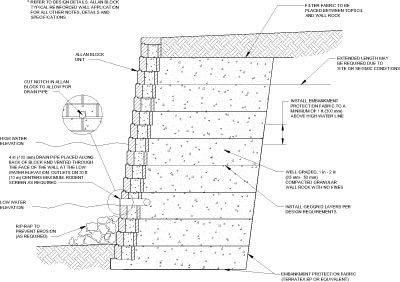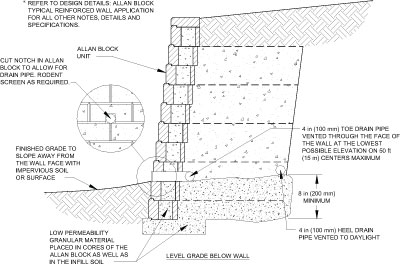Technical Newsletter
Issue 21
Project Information
Name:Edison Town Square
Product:AB Classic
Size: 35,000 ft² (3250 m²)
Local Engineer: Menlo Engineering Assoc.& Land Tek Consulting
Contractor: Argus Construction
Allan Block Manufacturer:Clayton Block
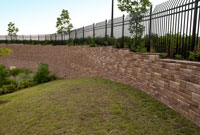

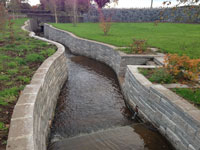

Water application walls should be constructed with clean, washed gravel in the entire infill zone. Doing this allows water to rise and fall inside the mass the same as outside the wall. This equal water level maintains equal pressure on both side of the facing and allows the engineer to design the wall without using hydrostatic pressures.
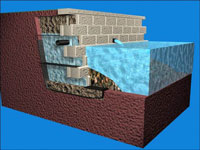

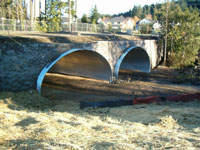
Watershed Preserved with Style
When the city of Edison, NJ approved the plans for the Edison Towne Square project they knew they were not only getting a new shopping and retail center, they were also getting the solution to the local water drainage issues. City planners hired Menlo Engineering Assoc. to develop the site plans and Land Tek Consulting was hired to do the final designs and site inspection of the retaining walls. The detention basin the city required was not only to be functional, it also had to look great to complement the new development. The city chose Allan Block’s AB Collection Ashlar Blend for its highly aesthetic four-block pattern made by the local manufacturer, Clayton Block Company of Edison, NJ. Clayton Block representatives worked directly with the developers and city planner to choose block colors and Land Tek and Menlo worked through the design process.
This complicated site has roughly 100 acres of watershed draining to the basin which included the new development and adjacent interstate highway. To add complication, the local water table was only a few feet below the surface. Therefore, the design and construction plans were developed with water management as the highest priority. Land Tek followed typical water application design and construction procedures provided by Allan Block Corp. and the NCMA for all basin walls. These walls were designed with high quality clean gravel infill material from wall face to the back of the reinforced geogrid mass and the infill was installed in 8 in. (200 mm) compacted layers up to a height of 1 ft (25 mm) above the high water mark. Building the wall with washed rock promotes rapid drainage and eliminates the buildup of hydrostatic pressures behind the wall facing as the basin level fluctuates.
During the design process water storage volume and overflow discharge management had to be reconsidered due to required site changes. These changes forced Land Tek and Menlo to develop a detailed underdrain system to increase storage capacity. Land Tek was able to increase basin capacity by designing a larger leveling base under the walls that Menlo connected to the underdrain system. The city and DOT worked out the overflow system to be connected to the Interstate highway drainage system.
During construction, excavation was complicated due to the high water table. The wall builder, Argus Construction, utilized an aggressive dewatering technique and Land Tek modified the design for additional buried block courses to compliment the process and provide a competent base for construction. Once the walls were out of the ground, construction proceeded without delay to completion.
Designing SRW Water Applications
Water applications using segmental retaining wall units are as common place as any other type of wall system. They include detention basins, ponds, lakes, rivers, wetlands and others. The engineering of a water application wall is the same as standard walls due to the design assumption that no hydrostatic pressure exists inside the reinforced mass. The segmental retaining wall industry ignores hydrostatic pressures if the reinforced mass is constructed using a free-draining gravel, with virtually no fine-grained particles. This material is often referred to as wall rock. The concept is that as the water rises and falls on the face, it also rises and falls inside the mass, therefore keeping the water pressure equal inside and out of the mass. In the case of a rapid drawdown of water level, the wall rock allows the water behind the wall to evacuate the mass almost as fast as the water is dropping, thus again keeping the pressure equal inside and out.
Understanding that the design methodology does not change for water applications, is important in understanding how the walls function. However, there are a number of detailing options the designer must work into their shop drawings besides the inclusion of the free-draining gravel. The mass should be lined with an embankment protection fabric to protect against fines from the retained soils being drawn into the reinforced zone as water levels fluctuate. Filter fabric should be placed horizontally above the wall rock, below the top soil, to prevent soil from migrating down into the reinforced mass. The placement of the drain pipe is different than a non-water application wall as well. It should be placed just above the low water mark, allowing the water to evacuate easily from behind the wall facing as the water levels drop.
Additionally the designer needs to consider the wall embedment and the placement of rip-rap at the toe for protection against erosion and scour. Understanding the type of water surrounding the completed wall structure is key to designing the proper erosion protection. Rip-rap can be natural boulders, cobbles or prefabricated erosion control mats. Each project will have a specific protection requirement, whether complex or simple. The key is to understand your project before beginning your design so you can make the right detailing decisions.
Construction Tips for Water Applications
Constructing a water application wall can be as easy as building any other type of application, if the site is dry or dewatered. Dewatering a site can be a complicated process of building a cofferdam of sandbags or sheet piling then dewatering with pumps to dry the site. Understand that the dewatering process can be very expensive, so having a detailed and correct bid is essential to a successful project.
Often the walls are built in the dry season or during the winter when the ice can be removed to allow for excavation. The contractor must follow proper winter building techniques and use gravel type soils that are not subject to freezing and are easily compactable. In some applications an alternate base may be required so water inside the mass will not pond in the portion of wall that is lower than the base of the pond. By using an impermeable granular material, a shelf can be created that is level with the pond bottom. With this material in place, during dry times the wall structure is also dry with no water standing below the pond level.
Construction Tips
Water applications often require culverts. Depending on the type of culvert used, the contractor must take into account its flexibility during construction. Corrugated steel culverts have the most flex compared to precast concrete culverts. The contractor must build the walls symmetrically to ensure a balanced, even flex until the walls meet up at the crown of the culvert. If the walls are built and backfilled to the culvert crown on one side, prior to any construction on the other side, the culvert will deform causing defaulting matching up the walls at the top.
For storm water pipes carrying water through the wall into the basin or pond, the designer should have additional drainage rock placed around the pipe in the reinforced zone behind the wall facing. This additional washed rock will allow water that may leak from the pipe over time to evacuate from the wall’s backfill. If additional drainage rock is not used and the pipe leaks, the unintended water flow could cause serious internal damage to the wall system. Additionally, for pipes that carry flowing water, the designer must evaluate the outflow and use rip-rap or other surfacing material in front of the wall for erosion control.
For more information on culvert openings and wall penetrations, see Allan Block Technical Newsletter Issue 17, First Quarter 2013.



